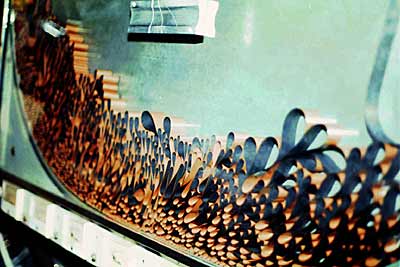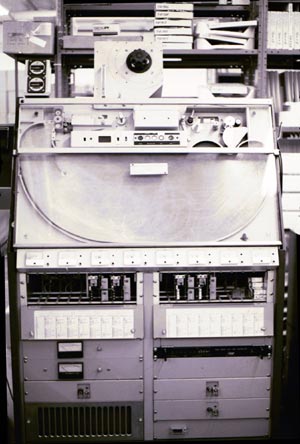







New! Skip ahead to Part 2 if you've already read this section
I worked in the Ampex Tape Duplication facility in Elk Grove Village, Illinois from September of 1970 to June of 1971 during my early college career. It was a lot of fun to try and remember everything, and in my mind I can still walk around the plant and visualize all the equipment. Our son has all my old cartridges and equipment and most of them still sound great. Sadly, I have no photos of the equipment used to manufacture the tapes because of course they didn't allow cameras inside the plant.
 |
| Close-up of tape in master playback machine (see machine below) This 1" tape has the original 8 tracks of music, and is used as the playback source for the 8-track slave recorders. It travels in a loop, and is bunched loosely in this glass enclosure. |
 |
Upon being newly hired in 1970, I had no real idea of how tapes were commercially duplicated, thinking that they must be copied in banks of tape recorders similar to how someone would do it at home. Most people also harbor this same notion. Well, the same principle applied, but the equipment was totally different from home gear. All the tapes we produced there, whether open reel, cassette or 8-track, were duplicated in roughly the following manner: master tape machines each having a number of recording slaves, reel winding machines followed by one form of cutter or another, then leader/hub/trigger tape splicing, insertion into a case or box, labeling and finally packing.
A master tape, 1" in width, was run in a continuous loop through a refrigerator-sized playback machine. It looked strikingly similar to a 1950's computer tape drive, and had many of the same features, including vacuum chambers to take up the slack of the tape before and after it was fed through the playback tape head. The playback heads were specially made for us in Palatine, Illinois, and were very, very expensive. Since these master tapes ran at 10x "normal" speed, the tape heads wore out rather quickly. There was a similar problem with the recording heads, though 10x on the recording end was about 1/4 the master playback speed, so they lasted a lot longer.
A specially trained technician checked the alignment and condition of the master tape machines, and only he/she was allowed to work on them. The line operators would often plug headphones into the auxiliary outputs of these machines, and even at 10x or 20x playback speed, they could spot defects and developing problems. After some number of playbacks, the tapes developed shiny spots where the oxide wore thin, and sometimes they creased or wrinkled. The lead operators would catch these defects because the thin spots in the oxide would sound muffled and any creases would make a hair-raising grating noise at 20x playback. They would stop the line immediately if these were heard. I plugged into the machines only occasionally because I was the only electronics line equipment technician for the entire shift and was often quite busy.
The lead person on the line would carefully unload the master tapes from reels and splice them in the playback machines. When loaded, these tapes resembled a jumble of loosely looped Christmas ribbon in a glass-front case. It fed out from one half of the glass case and dumped into the other half. As I didn't work on these machines myself, I didn't get glimpses of the internal controls or mechanisms much, but they didn't appear to be particularly complex. They were really neat to watch though, sort of like giant $20,000 Lava Lights with frantically moving loops of Mylar tape instead of hot wax.
The eight track master tape had all eight tracks recorded in the "forward" direction. When played for duplication, all eight channels were reproduced simultaneously. All the master tapes shared one common feature. Anyone with a good enough sound reproduction system and younger ears has heard the "trigger" or "pilot" tones at the end (and sometimes the start) of the audio tracks. They were recorded real-time at 20 hertz, and on most playback systems of the time were well below the reproduction range of the electronics and speakers. The purpose for these tones was to tell the recording and reeling machines when to switch hubs or when to stop for cuts or splices. If you listen to pre-recorded tapes very carefully, you will hear them as a very low pitch rumble just about the time the tracks are going to switch. It has been likened to running a car over a series of grooves in pavement. Watch your woofer cones and you'll might see them vibrate even if you can't hear them.